Why do you think all Kindergarteners are made to engage in activities like clay play, puppet-making, coloring, etc in their classrooms? It is because these fine motor activities help develop their fine motor skills. With these activities, your child will have fun while improving their hand–eye coordination, manual dexterity and more.
Math & ELA | PreK To Grade 5
Kids see fun.
You see real learning outcomes.
Watch your kids fall in love with math & reading through our scientifically designed curriculum.
Parents, try for free Teachers, use for free
Now let’s understand fine-motor skills and their importance for children in detail
Fine Motor Skills: An Overview

Fine motor skills are the small movements of hands, wrists, fingers, and toes. These skills develop throughout childhood and continue to improve as you grow. Many everyday activities require fine motor skills, such as writing, buttoning a shirt, or tying shoelaces.
For children, developing fine motor skills is an essential part of learning to perform daily tasks independently. Occupational therapists often work with children to improve their fine motor skills through exercises targeting the muscles and joints used for small movements. However, you can also incorporate fine motor skills activities into your child’s daily playtime to encourage development in a fun and natural way.
What Are Fine Motor Skill Activities?
Fine motor skills are the small movements that we use to manipulate objects. These skills develop gradually over time, starting from birth. For example, a newborn baby will learn how to grip and hold objects as they grow and gain strength in their hands and fingers. Eventually, they will learn to use utensils, write and perform other tasks that require more dexterity. While some children may pick up these skills very quickly, others may follow them up in some time.
However, there are also several things that parents can do to help their children develop their fine motor skills. One of the best ways to encourage these skills is through playtime activities that involve manipulating objects. These motor skill activities can range from simple tasks like stringing beads to more complex ones like cutting with scissors.
5 Reasons Fine Motor Skill Development is Important in Kids
Strong fine motor skills are essential for a child’s overall development and independence. Here are several reasons why it’s important to encourage fine motor skills in kids:
1. Academic Readiness: Fine motor skills are essential for success in school. Handwriting, drawing, and using tools like pencils, scissors, and rulers all require refined fine motor control.
2. Self-Care Independence: Fine motor skills are vital for performing essential self-care tasks such as dressing, buttoning clothes, tying shoelaces, brushing teeth, and using utensils.
3. Hand-Eye Coordination: Fine motor skill activities enhance the coordination between the eyes and hands, which is essential for tasks like catching a ball, threading a needle, or even using a computer mouse.
4. Cognitive Development: Engaging in fine motor activities encourages cognitive development. Activities like puzzles, intricate building, and threading beads promote problem-solving, spatial awareness, and critical thinking skills.
5. Artistic Expression: Developing fine motor skills allows children to express themselves creatively through art. Painting, drawing, sculpting, and crafting become more detailed and intricate as fine motor control improves.
Now that we’ve discussed the importance of fine motor skills, let’s dive into some fun activities to help kids improve their small muscle control.
Related Reading: Painting Ideas Kids Can Have Fun With & Easily Pull Off
40 Best Fine Motor Activities for Kids of All Ages
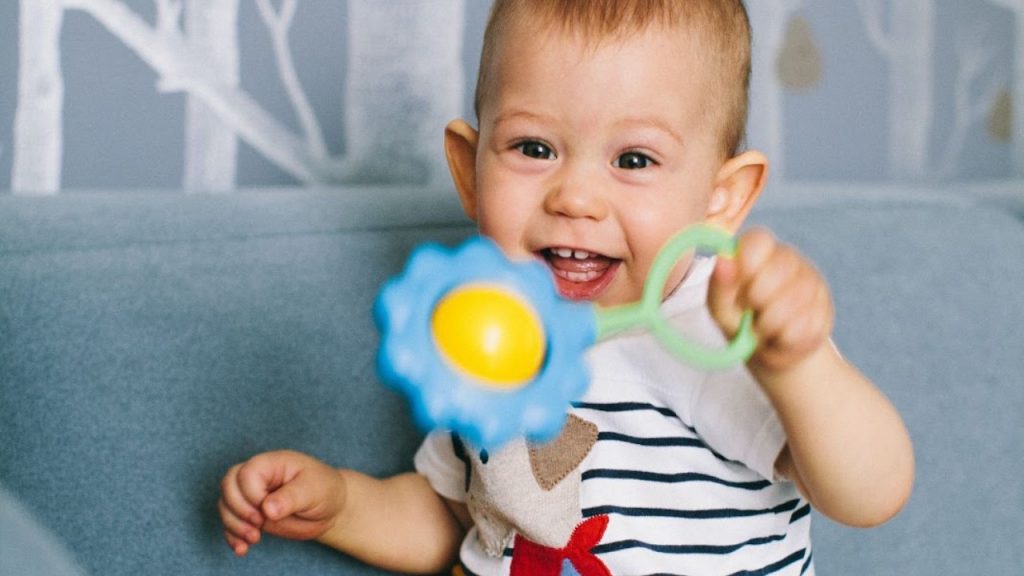
When choosing activities for kids, consider their age and ability. The list is divided into age groups, but don’t hesitate to adjust the difficulty level or provide assistance as needed.
Fine Motor Activities for Infants (0–1 Year)
1. Grasping and Shaking Rattles
Provide your infant with a rattle and show them how to hold it and shake it, helping them practice their grip strength. If they are still working on hand–eye coordination, you can also guide their hand to shake the rattle near their eyes or ears so they can see and hear the effects of their movements.
2. Transferring Objects
Place a selection of small objects in front of your infant and show them how to grab one object and release it into a different container. This activity helps with in-hand manipulation skills and developing their pincer grasp (using the thumb and pointer finger).
3. Finger Food Play
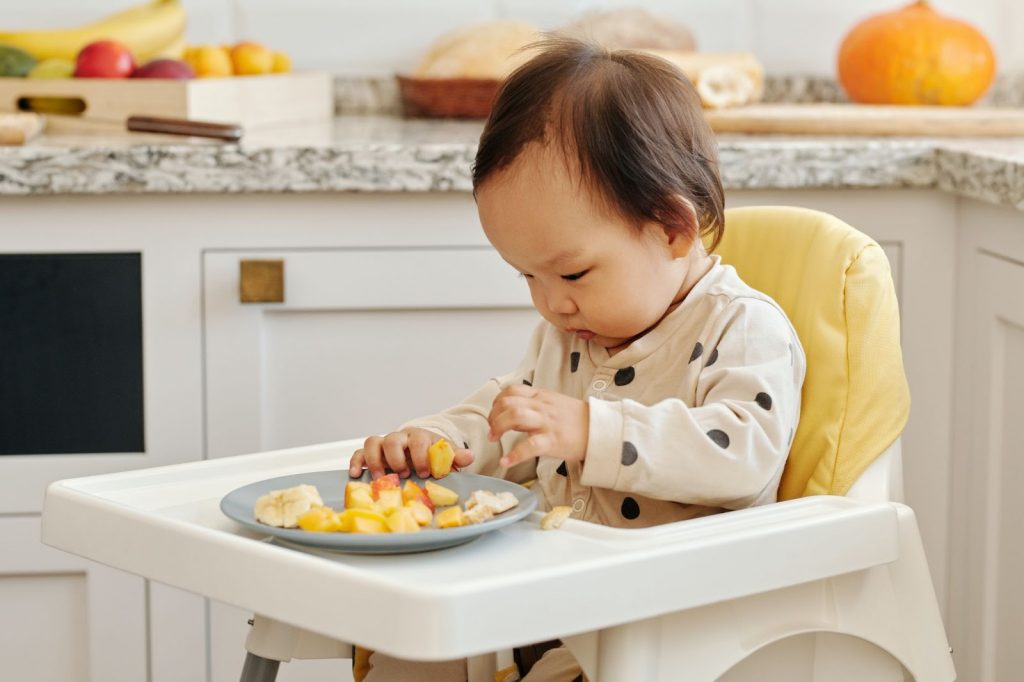
Offer your infant a variety of finger foods such as Cheerios or mini pancakes. Encourage them to pick up the items with their fingers and bring them to their mouth. This activity is for infants over six months old and helps with hand strength and coordination.
4. Squeeze Toys
When your infant is able to grasp objects, provide them with squeeze toys such as rubber duckies or animals. Encourage them to squeeze the toy, working on their hand muscles and grip strength. You can also try hiding small objects inside a squeezable container for extra fine motor practice.
5. Folding or Crumpling Paper
Provide your infant with a sheet of paper and show them how to fold it or crumple it in their hands. This helps with hand strength and dexterity, as well as introducing them to the concept of manipulating objects. As they age, you can also introduce activities like tearing paper or cutting with toy scissors for further fine motor practice.
6. Pick Up and Release
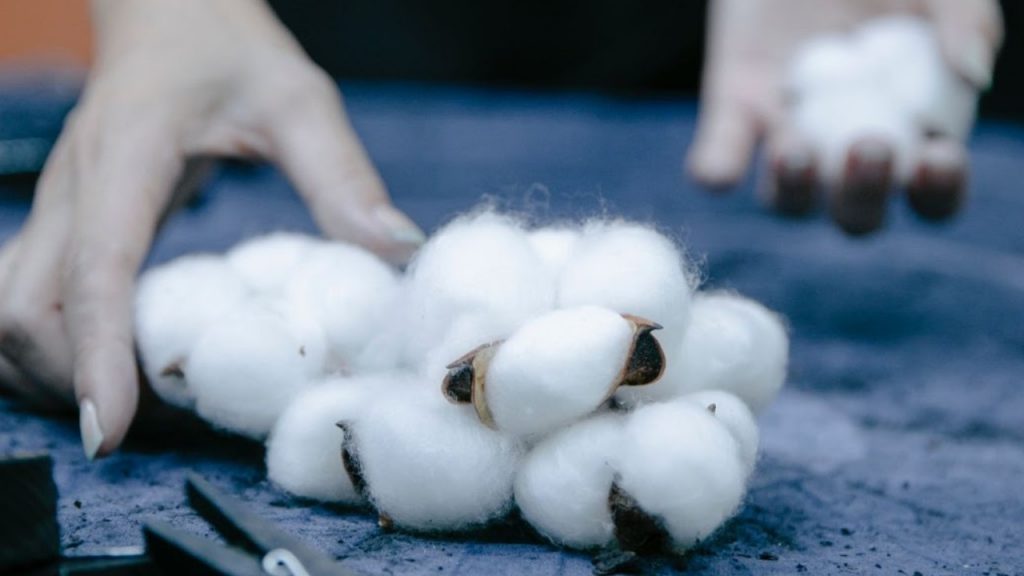
Place a selection of small objects, such as cotton balls or pom-poms, in front of your infant and show them how to pick them up with their fingers and release them. This helps with hand muscles and developing their pincer grasp. For added difficulty, try placing the objects inside a container with holes just big enough for them to fit their fingers through.
7. Pulling Apart Cotton Balls
No need to buy special toys for this activity—just provide your infant with a few cotton balls and show them how to pull them apart with their fingers. This helps with hand strength and developing their pincer grasp, as well as introducing them to the concept of manipulating objects.
8. Banging Objects
If your toddler loves making noise, provide them with wooden spoons or plastic containers and show them how to bang them together. You can also introduce them to banging on a drum or other musical instruments when they are older for further fine motor practice.
9. Give Them a Crayon
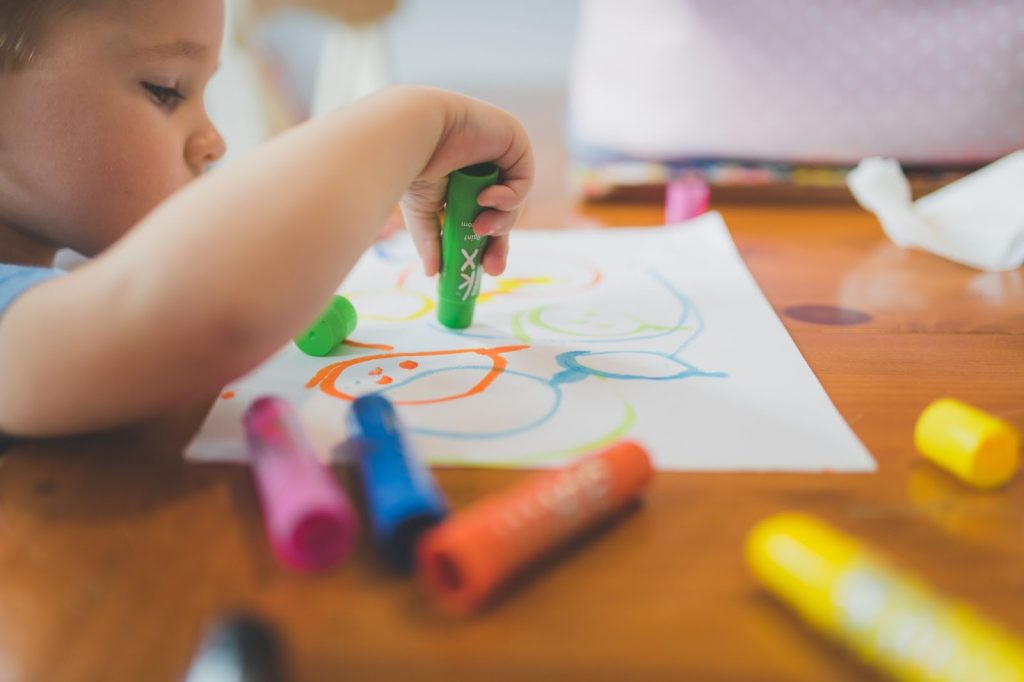
When your infant is close to their first birthday, give them a crayon and a piece of paper to scribble on. You can show them how to hold the crayon and make marks on the paper, helping with hand strength and dexterity. As they get older, continue to provide them with various writing utensils for further fine motor practice.
10. Self-feeding
As your infant becomes more interested in feeding themselves, encourage them to pick up small pieces of food with their fingers and bring them to their mouth. When they are ready, introduce utensils like spoon for them to practice self-feeding while they eat. This helps with hand muscles and coordination.
Related Reading: Playful Activities for 1-Year-Old Toddlers to Learn and Have Fun
Fine Motor Activities for Toddlers (1–3 Years)
We have further divided this list into two sections: activities for one-year-olds and activities for two-year-olds.
- Fine Motor Activities for 1-Year-Olds
If you’ve got a one-year-old, you know they’re always on the move! As they start to explore their world, they’re also developing their fine motor skills. So here are some fun activities for one-year-olds to help them practice those skills:
11. Sticker Placement
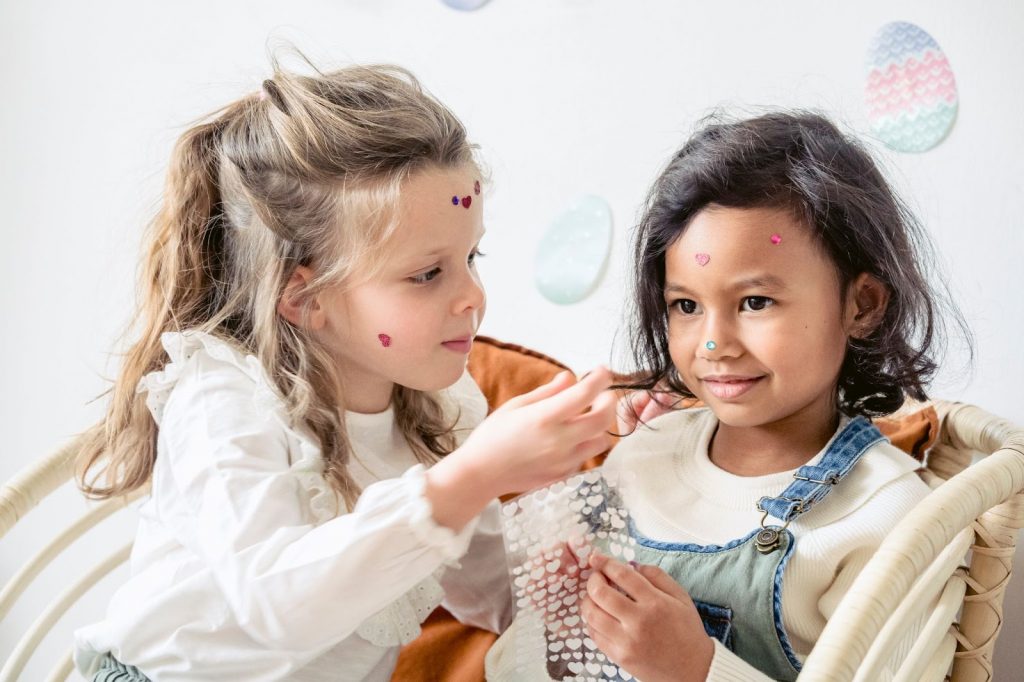
Using sticker books or simply providing your one year old with some stickers and paper is a great fine motor activity. No need to worry about them placing the sticker perfectly—just let them have fun exploring their creativity and developing those crucial fine motor skills. With practice, they’ll start to develop the precision and control needed for more advanced tasks.
12. Building with DUPLO or Mega Bloks
One-year-olds are at a stage where they’re starting to develop their fine motor skills. That means they’re learning how to use their small muscles, like those in their hands and fingers, to do things like pick up small objects, turn doorknobs, and stack blocks. Building with DUPLO or Mega Bloks is a great way to help them practice those skills. Not only is it fun, but it also gives them a chance to experiment and figure out how things work.
13. Pom Pom Sorting
This is a simple yet effective fine motor activity for one year olds. To set up the activity, you will need a selection of pom poms in different colors and small containers. Show your child how to pick up a pom pom and drop it into one of the containers. Then let them have a go. They will build up their hand muscles and improve their coordination as they sort the pom poms.
14. Stacking Cups or Rings:
Offer stacking cups or rings that they can stack and unstack. This activity develops hand-eye coordination and encourages them to explore size relationships.
15. Edible Sand Play
Have you ever heard of edible sand? It’s simply a mixture of equal parts flour and oil, and it makes for a great sensory activity. Set out some bowls or containers filled with edible sand and provide your one-year-old with small utensils like mini shovels or spoons. They will have fun exploring the texture while also practicing their fine motor skills by scooping and pouring the sand.
- Fine Motor Activities for 2-Year-Olds
Two-year-olds are starting to use their hands with more precision and control, so here are some activities to help them continue to develop those skills:
16. Puzzle Play
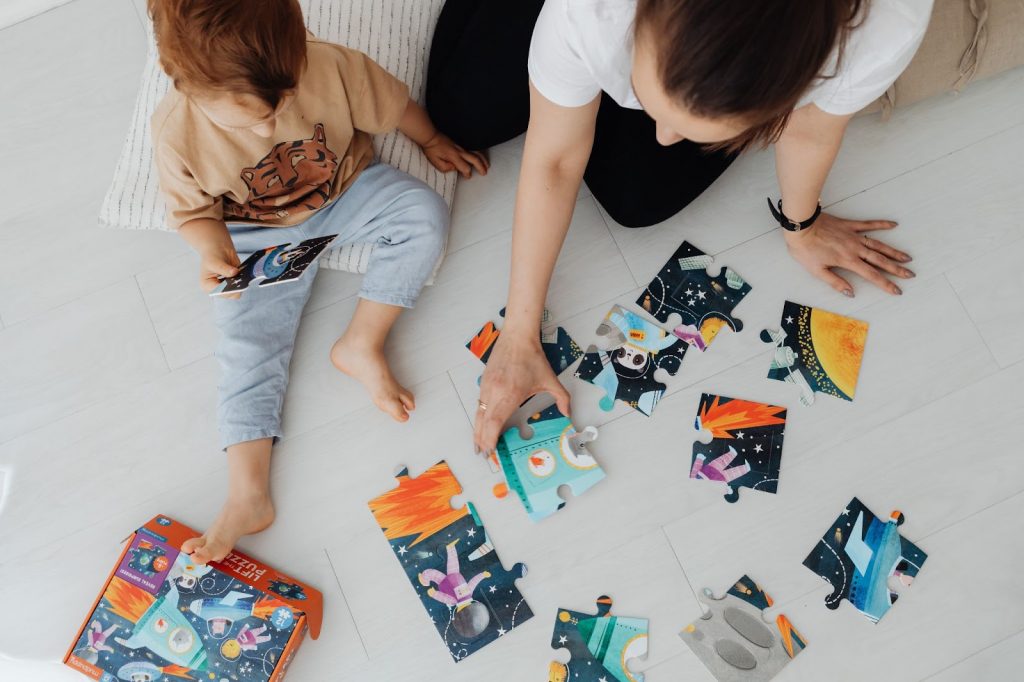
Puzzles offer a great fine motor opportunity for two year olds as they work on their hand muscles and improve their coordination. Start with puzzles with just a few large pieces, then gradually increase the difficulty as your child’s skills improve. You can also try using other small objects like blocks or buttons for puzzle play.
17. Opening and Closing Containers
Two-year-olds are starting to develop their hand muscles, so helping them practice opening and closing containers is a great fine motor activity. Start with jars or containers with large, easy-to-grip lids and then gradually make it more challenging for them by using smaller containers or tighter lids.
18. Whisking and Mixing
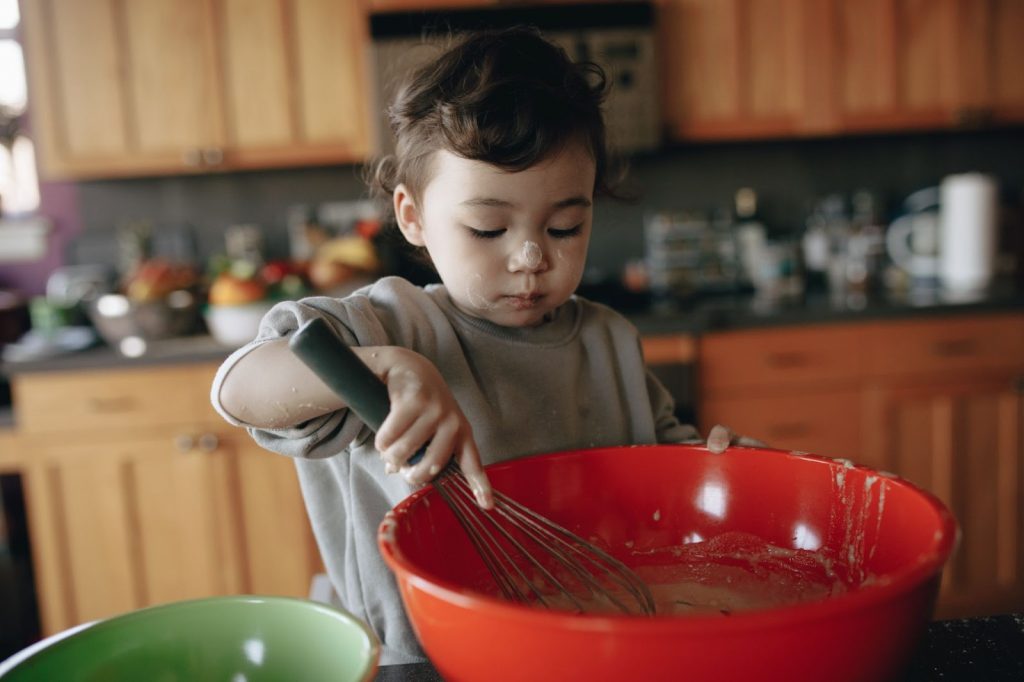
Some simple kitchen activities can be great fine motor practice for two-year-olds. Whisking and mixing ingredients is a fun way for them to work on their hand muscles and coordination, and it also helps introduce them to cooking and the concept of following directions. Just make sure you supervise closely to avoid any accidents.
19. Pushing Coins into a Piggy Bank
This activity helps with hand strength and dexterity. Have your child grab coins, hold them between their thumb and pointer finger, and push them into a piggy bank or empty water bottle. This not only helps with fine motor skills, but it can also teach them about saving money. You can also try using small plastic caps or buttons for a similar activity.
20. Brushing Teeth
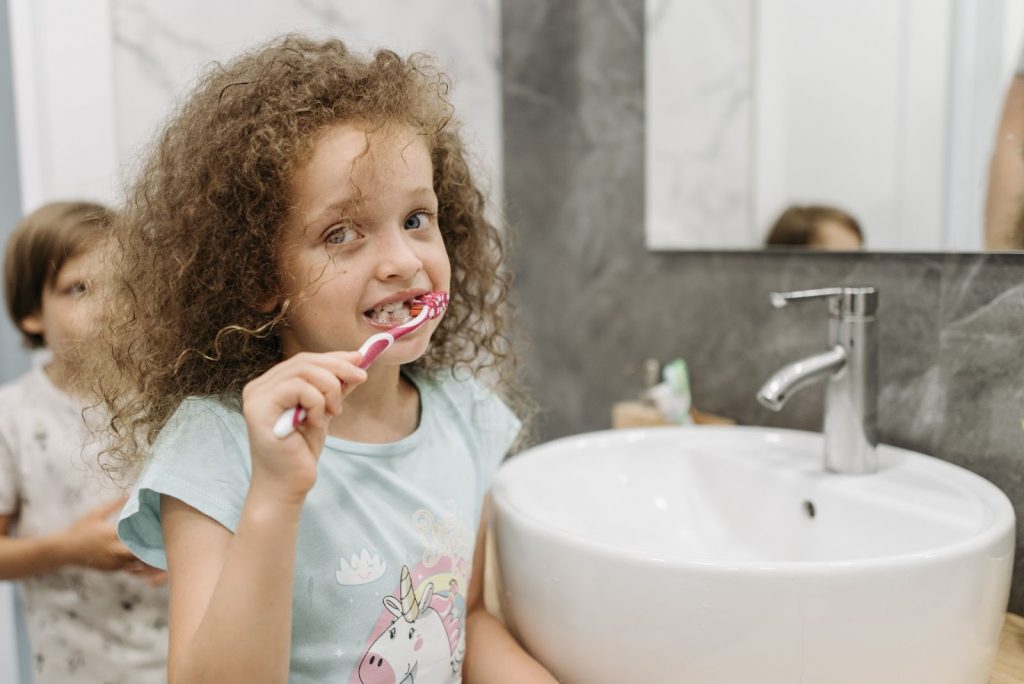
Brushing teeth may seem mundane, but it’s a great way for two year olds to practice their fine motor skills. Have them hold the toothbrush and show them how to move it in small circles around their teeth. They can also practice squeezing out a pea-sized amount of toothpaste onto the brush. Not only will they improve their hand muscles, but they’ll also be set up for good oral hygiene habits.
Related Reading: 20+ Best Learning Activities for 2 Year Olds
Fine Motor Activities for Preschoolers (3–4 Years)
To list a few preschool fine motor skills activities that can be practiced with your children at home are as follows:
21. Dot-to-Dot Coloring
Provide dot-to-dot worksheets or books where they connect numbered dots to reveal hidden pictures. This activity helps them practice controlled hand movements.
22. Tracing Shapes
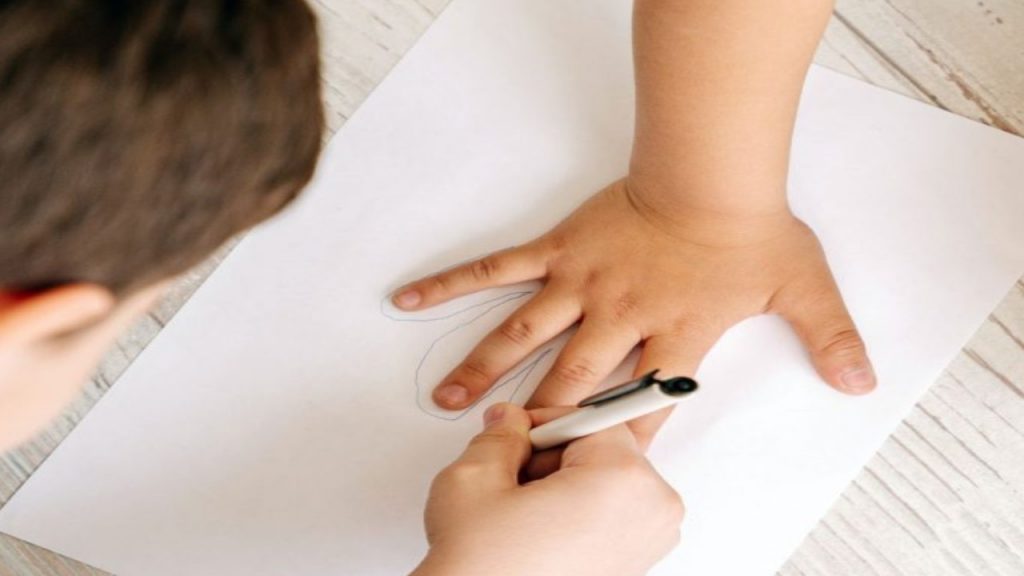
Provide kids with plastic toys or stencils or rulers of different shapes. Have them trace the shapes using crayons, colored pencils, or markers. This will improve their hand and eye coordination and refine hand movements and control.
23. Lacing Cards
Offer cards with holes around the edges and shoelaces. They can practice threading the lace through these holes.
24. Connecting Links
Offer plastic linking toys or large paper clips that they can connect to create chains or patterns.
25. Tong Transfer
When it comes to fine motor skills, using the pincer grasp (using the thumb and pointer finger to pick up objects) is important for future writing abilities. To practice this grip, provide your child with tongs or tweezers and small objects, such as pom-poms or beads. Have them use the tongs to transfer the objects from one bowl to another, working on their hand–eye coordination and precision.
26. Tower from Fruit Loop
No need for expensive, specialty materials for this activity—a simple bowl of Fruit Loops cereal can provide hours of fine motor fun. Have your child use their fingers to pick up individual pieces and stack them on top of each other to create a tower. While playing, they’ll also strengthen their hand and finger muscles.
27. Pasta Play
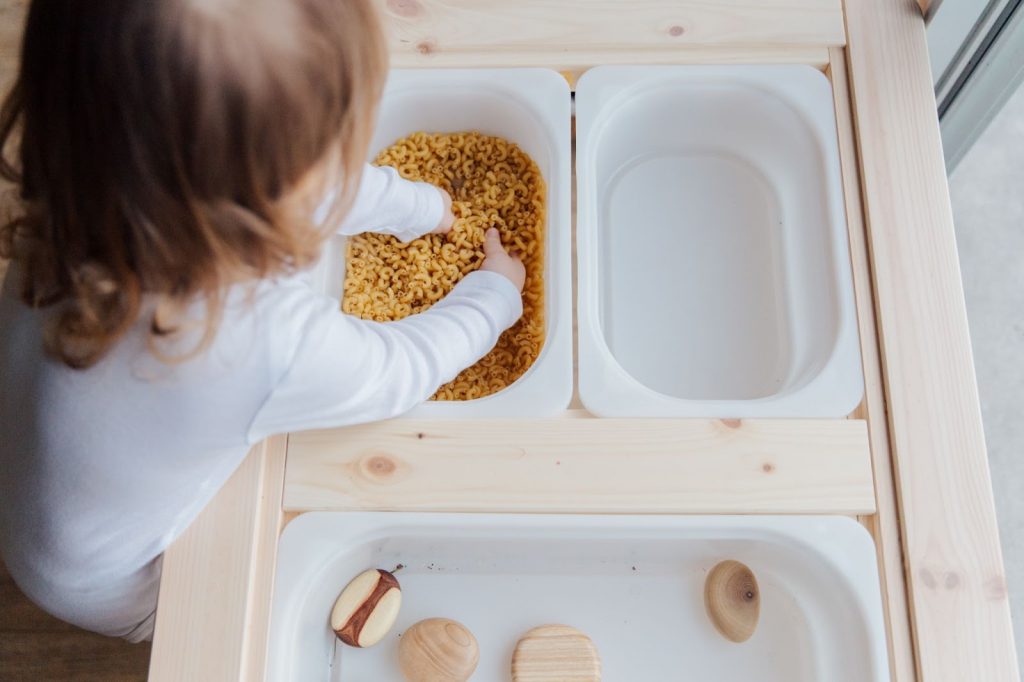
Dry pasta comes in various shapes and colors, making it perfect for fine motor play. Have your child use their fingers to sort the pasta by color or shape, practice threading it on to string or pipe cleaners, or even create designs on a piece of paper by gluing the pasta on to it. And bonus—this activity also helps improve counting and sorting skills.
28. Marshmallow Sculptures
Did you know marshmallows make for a great fine motor activity? Provide your child with some mini marshmallows and toothpicks for this one. Have them use their fingers to pick up the marshmallows and place them on to the toothpicks to create sculptures—animals, shapes, or buildings are all fun options.
29. Popping Bubble Wrap
Who knew popping bubble wrap could offer so many fine motor benefits? Have your child lay down a sheet of bubble wrap and use their fingers for popping the bubbles, strengthening hand muscles and improving coordination. You can also have them trace over the popped bubbles with a marker for added challenges.
30. Dyed Rice Sensory Bin
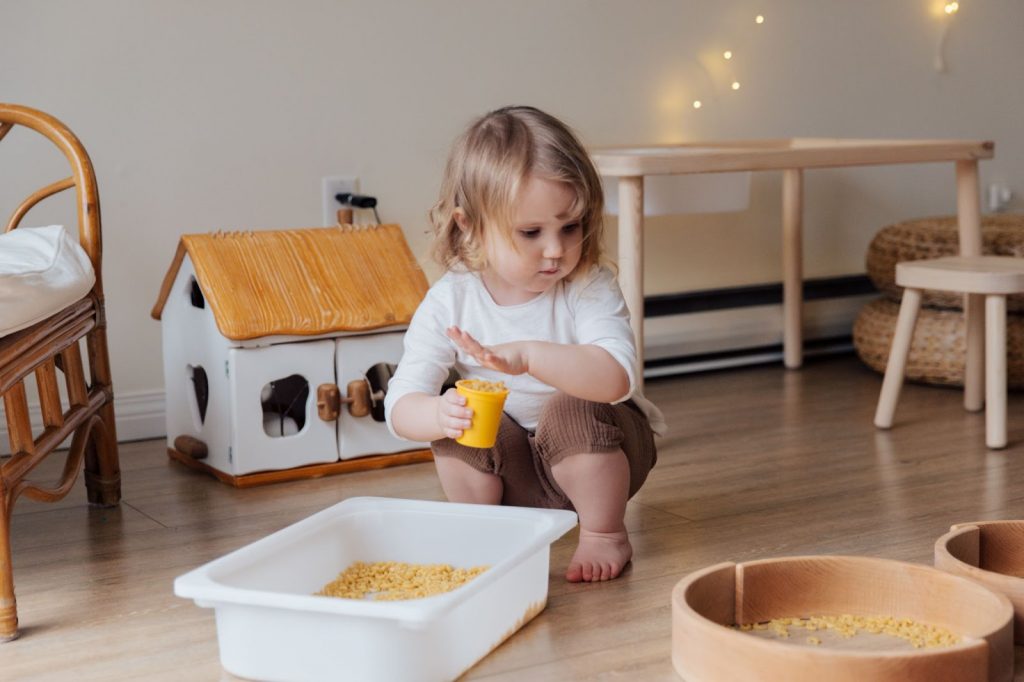
Sensory bins can provide various fine motor opportunities, and this dyed rice sensory bin is no exception. Fill a bin with white rice that has been dyed with different colors, and provide your child with tongs, scoopers, or tweezers to pick up the rice and transfer it into different containers. This activity helps improve hand–eye coordination, dexterity, and grasp.
Related Reading: Easy Activities for Preschoolers [With Tutorials]
Fine Motor Activities for Kindergarten (4–6 Years)
31. Playdough and Putty
Playdough and putty are two popular childhood materials that can offer more than just entertainment value. Squishing, pinching, and shaping the dough helps little ones develop the muscles in their hands and fingers. Not just for shaping and molding, playdough can also be used for activities like counting or letter recognition by making imprints with alphabet cookie cutters.
32. Threading with Beads
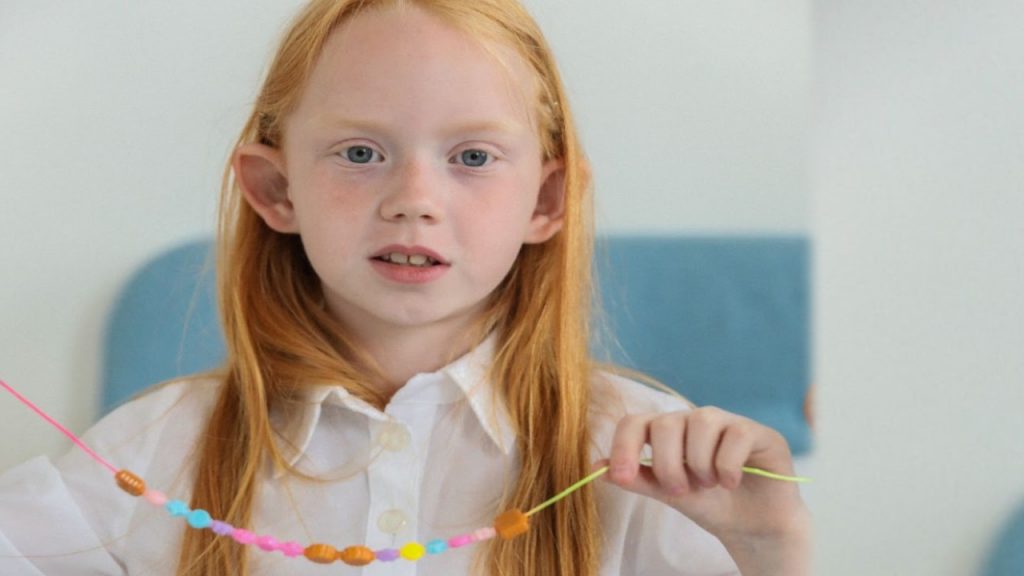
Threading with beads is a great way to develop motor skills in kids. Not only does it require coordination and precision, but it also helps to develop hand–eye coordination. In addition, threading with beads is a great way to encourage kids to be creative. They can experiment with different colors and patterns and even create their own jewelry.
33. Finger Painting
Finger painting may seem like a messy activity, but it’s actually a great way to improve fine motor skills. Kids can work on strengthening their hand muscles by pressing and spreading the paint on to the paper and exercising control with their fingers to create different designs and shapes. And, of course, finger painting also helps to develop creativity and self-expression.
Related Reading: 20 Painting Ideas Kids Can Have Fun With
34. Paper Folding
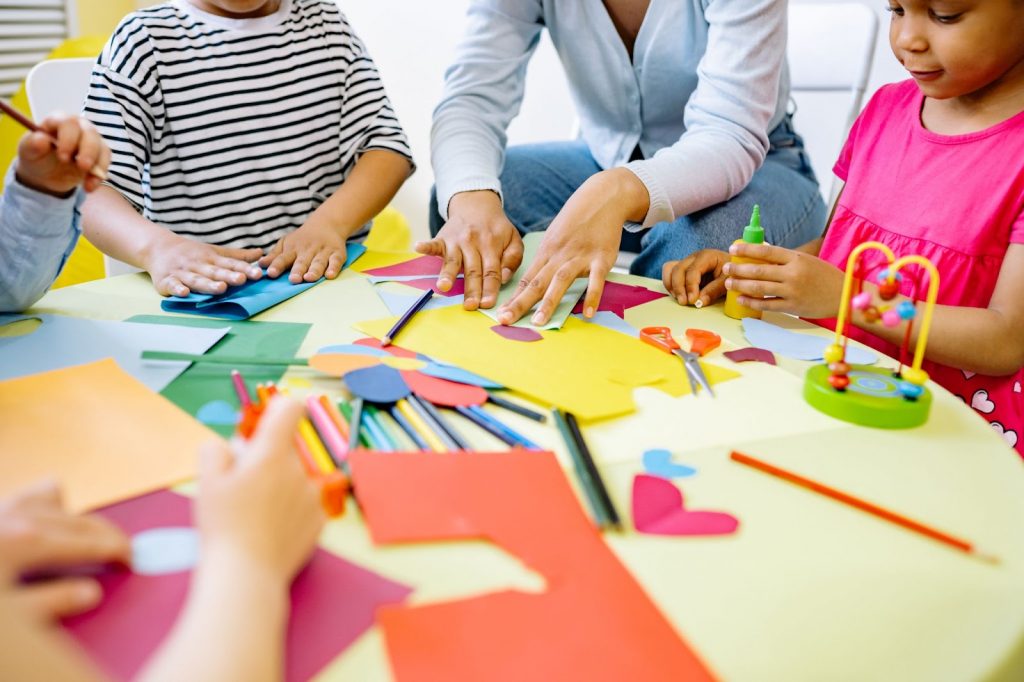
One way to develop fine motor skills is through paper folding activities. These activities require kids to use their fingers and hands to play with paper, strengthening the muscles and improving coordination. Paper folding activities can also help improve hand–eye coordination and visual perceptual skills. So, grab some paper and try out origami or even a simple paper airplane folding activity.
35. Cutting with Scissors
Scissor skills are essential for kids to learn as they start school and begin writing assignments. To practice scissor skills at home, provide your child with different materials to cut, such as construction paper, ribbon, or even foam sheets. This activity can also be paired with other tasks, such as cutting out shapes for a collage or cutting strips of paper for a ribbon weaving activity.
36. Drawing with Chalk
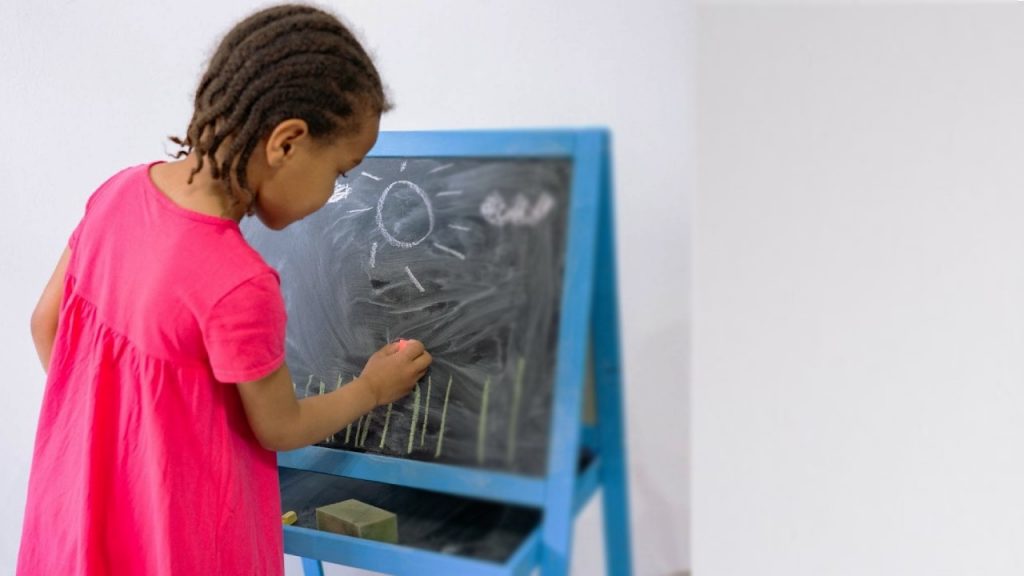
Drawing with chalk is a fun outdoor activity for kids that can also improve fine motor skills. Have your child experiment with different grips, such as the tripod grip (using the thumb and pointer finger to hold the chalk) or the dynamic tripod grip (using the thumb, pointer, and middle fingers). Encourage them to draw shapes and pictures, practicing control and precision with their fingers.
37. Water Transfer
The simple act of transferring water from one container to another helps build hand strength and coordination. Use pipettes, small funnels, or even just recycled water bottles with holes poked in the lid for pouring. Add in a little extra fun by using colored water and mixing colors together or playing a version of the classic game, “Hot Potato,” where kids pass around a cup of water before it spills.
38. Maze Activities:
Provide maze worksheets that require kids to navigate through the paths using a pencil or crayon. This activity hones their fine motor control as they try to ensure that their pencil/ crayon marks stay inside the boundary lines of the maze.
39. Gardening
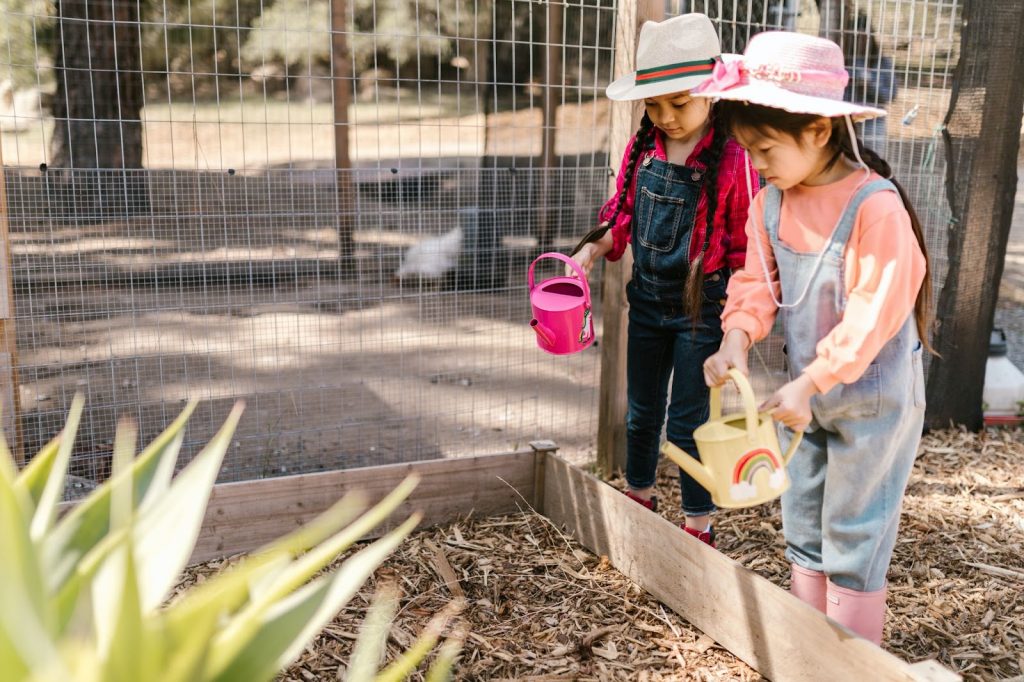
Digging in the dirt, planting seeds, and taking care of a garden are all tasks requiring fine motor skills. Kids can practice hand–eye coordination by watering plants with a watering can or precision by planting seeds in designated rows. Gardening is also an excellent way for kids to learn about nature and the importance of caring for the environment.
40. Lacing with Yarn
No need for expensive lacing cards or boards; simply provide your child with a piece of cardboard and some yarn for this fine motor activity. Have them practice threading the yarn in and out of the holes, controlling their fingers to create patterns. You can also make it into a fun game by creating a design or letter on the cardboard and having your child lace over it.
Related Reading: Engaging Math Activities For Kindergarten to Try at Home
Let’s Enhance Motor Skills Together!
There you have it! Your kids will love these fine motor skill activities, and you’ll see their skills improve with each one. Remember, every child develops at their own pace, so try not to compare them to others and just have fun while they learn and grow!
Don’t forget to make it fun for them—try using different materials or incorporating their favorite toys into the activity. And most importantly, have fun bonding with your little ones as they develop and enhance their motor skills. Happy playing!
Frequently Asked Questions (FAQs)
How long should I do these activities with my child?
This will vary for each child, but generally, 10–15 minutes of fine motor development activities a day is sufficient. You can also incorporate them into everyday tasks such as self-feeding or dressing themselves.
What should I do if my child isn’t able to do a certain activity?
Every child develops at their own pace, so try not to push them too much. If they are having trouble with a certain activity, try modifying it to make it easier for them, or try finding something else they enjoy doing to improve their fine motor skills.
What age is best for starting these activities with my child?
You can start introducing fine motor strengthening activities as early as infancy and keep adding more challenges to them as they grow.
























